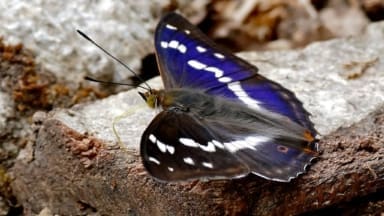
One of our biggest butterflies, the Purple Emperor is known to fly high in the tree-tops of woodland landscapes in central-southern England, where it feeds on aphid honeydew and tree sap – behaving more like a tropical butterfly. The adults are extremely elusive and occur at low densities over large areas. The males occasionally descend to the ground, usually in mid-morning, where they probe for salts either from road surfaces or from animal dung. Females resemble the White Admiral, but have an orange-ringed eyespot under the forewing.
The Purple Emperor declined steadily during the twentieth century and is now restricted to some of the larger woods in southern England. There has been a recent slight re-expansion in some areas – such as on the Knepp Estate. Based in Sussex, Knepp is the pioneering rewilding project that’s turned failing farm land into a profitable site of wildlife abundance. Since the project began, Knepp has seen extraordinary increases in wildlife where rare species such as turtle doves, nightingales, peregrine falcons and purple emperor butterflies are now breeding.
Thriving on sallow scrub, Purple Emperors are often seen aggressively defending their territories high in the canopy of our oak trees, or sipping on sap runs on damaged tree trunks. Vividly coloured males will even fend off birds many times their size. The Purple Emperors that call Knepp their home were featured in Sir David Attenborough’s Wild Isles on BBC One last year – still available to view on BBC iPlayer.
Purple emperors are one of the most astonishing successes of the Knepp rewilding project. None having were recorded in the recent past, but the estate is now home to the UK’s largest colony of this magnificent butterfly. Between the 29th of June and the 14th of July, Knepp organise Purple Emperor Safaris to see them.

